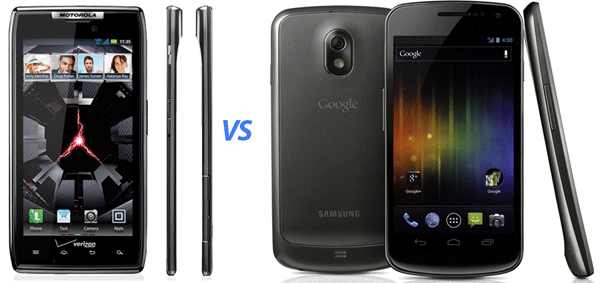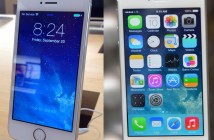
After Samsung and Google have just announced the Galaxy Nexus that is supposed to be the new flagship Android smartphone, Motorola (which is also owned by Google, by the way) was already hot on their trail with their Droid RAZR, which kind of took everyone by surprise and packs so many features that it leaves you wondering whether Google made the right choice by choosing Samsung to produce the Nexus.
Indeed, the Droid RAZR is an amazing smartphone and just about everyone can find something to be impressed about – it truly is a great continuation of the RAZR series that was so popular half a decade ago. In my opinion, it is better than the Galaxy Nexus, but as that phone carries Android 4.0 and is touted as the new flagship, it’s interesting to compare them both.
Exterior Design
Both the Droid RAZR and the Galaxy Nexus have their own unique attraction points when it comes to exterior design, and it would be hard to choose a winner here. The Droid RAZR continues the industrial look of its predecessors, with a new hexagonal shape, a nice big screen on the front covered fully by Gorilla glass, a Kevlar back for resistance to scratches and a full metal body that is simply necessary to make the 7.1mm device sturdy. Oh, yes, the RAZR is the thinnest smartphone in the world, as it should be obvious from the name, and only the hump at the top of the device is slightly thicker than the rest, but even then it’s only by 2mm.
The Galaxy Nexus takes a different approach – it’s got a stylish, rounded housing, with a curved display glass (which is not Gorilla glass, by the way) and an overall elegant finish. There are no navigation buttons, as Android 4.0 doesn’t need them anymore, and that makes it slightly smaller and easier to handle without accidentally touching those buttons. It’s also pretty slim at 8.94mm, and I don’t think 1.8mm really matter in everyday use (although of course, the Droid RAZR does look more impressive).
Display
Both the Droid RAZR and the Galaxy Nexus have very nice Super AMOLED displays, with a 4.3 inch qHD unit on the Droid RAZR and a new 4.65 inch, 1280×720 HD unit on the Galaxy Nexus. Obviously, resolution wise, the Galaxy Nexus wins, but the 4.3 inch, 960×540 pixels screen on the Droid RAZR is not to be laughed at either, offering the same clear and vivid picture, as well as a smaller footprint – the RAZR is pretty large in your hand, but the Galaxy Nexus is almost too big for one hand. Besides, even at qHD resolution, you can’t see the individual pixels, so there’s not much of an incentive to go higher.
Hardware features
The hardware features are pretty much the same on both devices, with a few notable exceptions. The processor is a TI OMAP 4 series, running at 1.2 GHz, with a factory overclocked PowerVR SGX540 graphics adapter and 1024 MB of RAM, so the performance should be the same on both phones. There are 32 GB of storage space in the Galaxy Nexus and 16 GB in the Droid RAZR, however the latter also has a microSD card slot, which can be used to add another 32 GB, making it slightly better than the GN if you need that much space. The card is also hot swappable, which is a bonus.
Aside from the usual USB, 3.5 mm audio jack, Wifi, Bluetooth and GPS, the Droid RAZR also has an 8 megapixels camera on the back (only 5 megapixels on the Nexus), Glonass support (for all the Russian buyers), an ever so slightly bigger batter (1780 mAh compared to the Galaxy Nexus’ 1750 mAh), separate USB/HDMI ports (more useful for docks than the combined port on the GN) and of course, support for 4G LTE networks, which is absent on the Galaxy Nexus. The Nexus has an NFC sensor, though, if you’ll ever need it.
Software
The software part may be the deciding factor for the first buyers – the Galaxy Nexus runs the new Android 4.0 Ice Cream Sandwich, which brings a lot of new features and improvements to the table, while the Droid RAZR runs Android 2.3.5 Gingerbread, which is still a great OS with no issues. The Droid RAZR will be getting the 4.0 update in a few months, though, so it might be worth the wait. Both phones’ interfaces have been customized, with Samsung’s Touch Wiz being a tad better than MotoBlur on the Droid.
I have to say that Motorola’s device still has a locked boot loader – that’s like a big FU to developers and hackers (the good kind). Despite all the features and advantages and my strong preference for the RAZR, I’m not going to buy it until it can run custom ROMs. I hope Motorola comes back to their senses and releases an unlock code for those who want it. Needless to say, the Galaxy Nexus will be open to any modifications, with the warranty being void in that case, of course.
Overall, I believe the Droid RAZR is a better choice than the Galaxy Nexus – the latter has only its bigger, higher resolution display and an NFC sensor as an advantage, while the Droid RAZR is slimmer, smaller, has 4G LTE support, a micro SD card slot, a separate HDMI port and it will cost the same as Samsung’s creation – that’s enough reasons for me to choose it.




4 Comments
need to check your specs on the GN, you mention above that it uses the samsung Touch Wiz UI and I don’t believe that’s a true statement. Most reviews and articles related to the GN state its the “pure” android experience with no 3rd party UI installed (Touch Wiz, Motoblur, Sense, etc.)
you also mentioned the GN does NOT have 4G support, that’s also incorrect. The Verizon version of GN being released shortly, will have 4G support for sure.
i agree with a lot of your comments and i think if the GN had kevlar and gorilla glass then it would be much more attractive. The big selling point for GN will the be fact that it’s another 4G phone with Android 4.0 “pure” (meaning no carrier bloatware and no 3rd party UI).
1.bloatware will ALWAYS slow down a device, no matter how fast the processor speed. Therefore, the pure OS on the GN makes it an overall “faster” device.
2. the camera on the GN has no-lag shutter, so overall picture quality will be the same, if not better
The specs on the phone really changed since he first rumors, you should check again